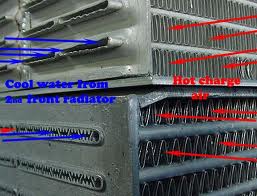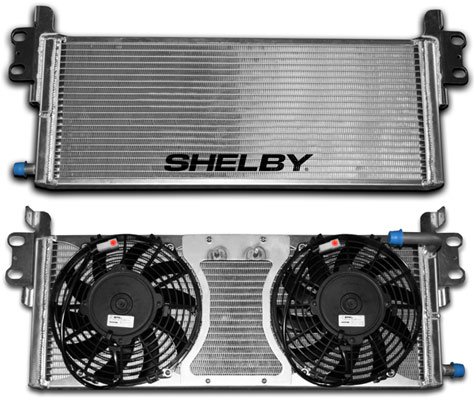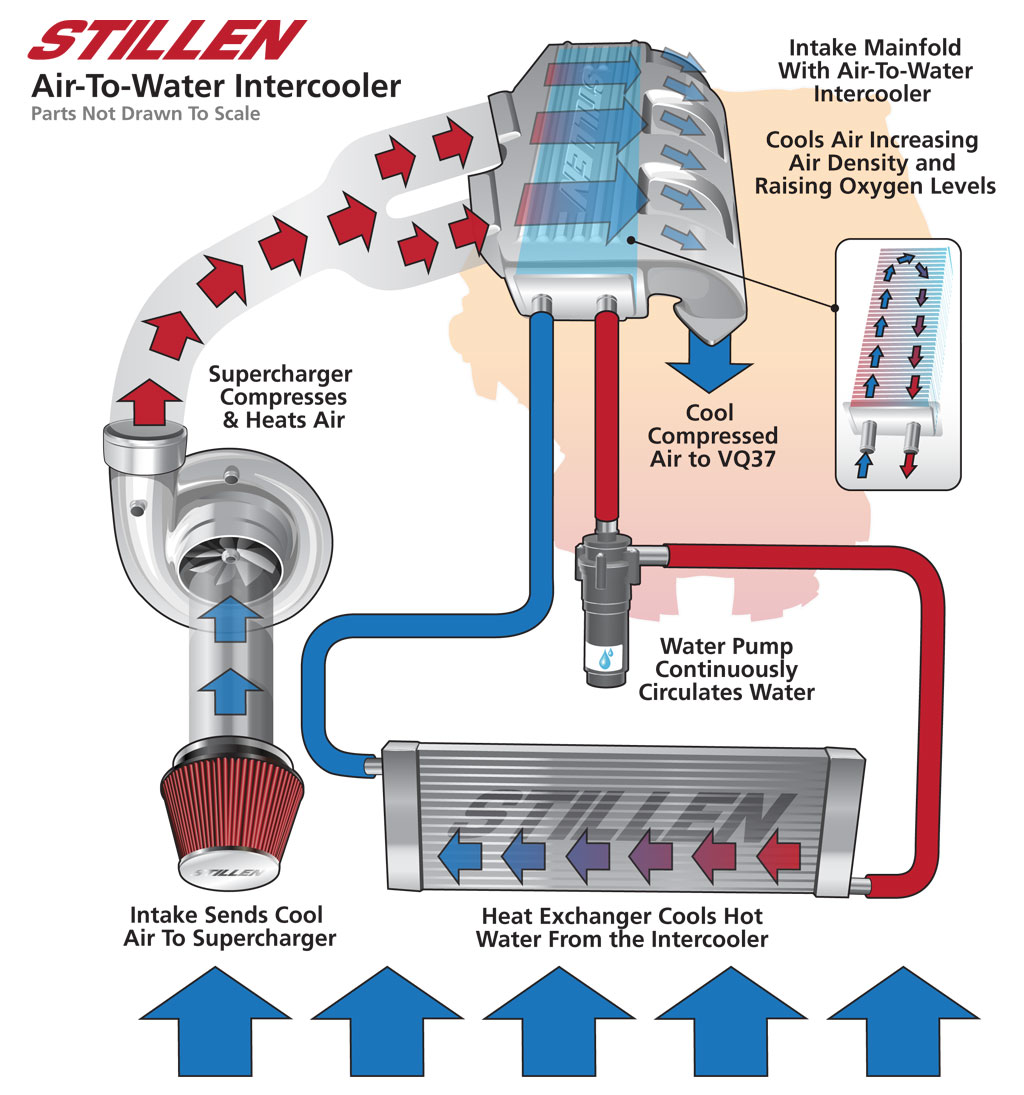| What's Hot! | Products/ Tools | EFI Tuning | Basic Tuning | Advanced Tuning | Chassis Tuning | Advertise with us |
Building a Competitive Air to Water Intercooler System
Contributed By: Enginebasics.com
There are four main area’s to building a successful and super efficient Water / Air Intercooler set-up.
1. The Actual Water to Air Intercooler
2. The Heat Exchanger
3. The pump
4. The lines
Now lets focus on each of those:
1. The Water to Air Intercooler
This could be the most important part of your system. Be sure to choose a Water to Air Intercooler that was designed with a W/A intercooler in mind. YES THAT’S RIGHT, the cores are different. Air to Air Intercoolers are set-up to have air flow across the core for cooling, and through the core for the air that is cooled to feed the motor. A water to air intercooler is engineered and designed to flow water across the cooling core, and air the other direction to feed the motor. There are many China companies that are just using air to air intercoolers, encasing them, and then running water through them and calling it good. Do they work? Sure, but they are by no means as efficient as they could have been if set-up to flow actual water or a liquid.

Also size. Be sure to select a size that is going to offer you enough efficient cooling and be able to flow the amount of CFM you need. Too small of a water to air intercooler will not only pull too little heat out of the charged air, but can also cause a flow restriction if you are trying to flow more CFM than that size intercooler can ingest.
2. The Heat Exchanger THE BIGGER THE BETTER.
That’s just how it goes, IF YOU CAN DEAL WITH THE WEIGHT. The goal of the heat exchanger is to keep the water as cool as possible. The easiest way to do this is by making sure that the water in the heat exchanger is being cooled off as much as possible. The larger the heat exchanger, the more energy that can be extracted from the water before it gets pumped back to the intercooler.

Another reason why bigger is better is to avoid heat soak. Water to air intercoolers need to have a certain volume of water flowing in the system. The idea is to extract heat out of the charged air and put it into the water. Once the water takes on that heat the goal is to relieve it at the exchanger. Having a larger volume of water just allows you a larger CAPACITY of heat you can extract. The down side is that water weights around 8.34 pounds per gallon. Setting up a SUPER efficient air to water system can also cost you a lot of weight, so don’t go overboard here.
3. The Air To Water Intercooler Pump

A good pump is important to make sure that you have a good volume of water flowing through your water to air intercooler. The goal is to always have fresh, cool water flowing through the intercooler and heat soaked water being pushed out. If the pump is not flowing enough volume of water, then the water could be getting heat soaked, and taking on to much heat in the intercooler before being cycled out.
4. The Air to Water Intercooler Lines
Nothing much to say here other than to be sure to NOT UNDERSIZE YOUR LINES. You might have spent good money on an efficient intercooler. Good money on a nice large exchanger, with a good volume of water running in your set-up. If you don’t have the lines to flow the water it all won’t matter in the end. Be sure to have good size lines that will be able to flow the volume of water needed to efficiently feed the air to water intercooler the amount of water it needs, and the heat exchanger the amount of water it needs.
Many companies are selling complete packages now making the process that much more simple:
Hopefully this gives you a little in-site on where to focus your efforts in setting up the best air to water intercooler set-up that you can. If you have any comments or questions be sure to contact us here at enginebasics.com
ATTENTION READER:
If you enjoyed the information and article you just read be sure to check out our newly released book with even more exciting photo's and information:How to Turbocharge and Tune your Engine

Want to know more about your particular Make and Model vehicle? All of these vehicles are covered in the tech, maintenance and repair articles found above. Enginebasics is the wiki or wikipedia of car part, repair, how to and tuning information. Let us be the class 101 for your automotive learning.
| Ford | General Motors GM | Pontiac | Jaguar | Land Rover | Nissan |
| Toyota | Honda | Lexus | Acura | Lotus | Scion |
| Infinity | BMW | Mercedes | Mitsubishi | Ferrari | Maserati |
| Lamborghini | Volks Wagen VW | Saab | Audi | Hyundai | Kia |
| Subaru | Mazda | Chevy | Volvo | Caddilac | Dodge |
| Chrylser | Daewoo | Porsche | Mercury | Freightliner | MG |
Individual Models
| Ford Mustang | Mitsubishi Eclipse | Mitsubishi Evo | Subaru WRX / STI | Dodge Viper | Chevrolet Corvette |
| Nissan Skyline | Honda S2000 | Nissan 350z | Toyota Supra | Chevy Camaro | Lotus Elise Exige |
| Honda Civic | VW Golf | Dodge SRT-4 | Eagle Talon | Acura Integra | BMW M3 |
| Nissan 240sx | Porsche 911 | Acura NSX | Honda Accord | Toyota Camry | Toyota MR2 |
| VW R32 | Dodge Truck | Mazda Rx7 | VW Jetta | Sand Buggy | Nissan Sentra |
For the latest Automotive news and stories visit the websites below |
Our feature Build: An AWD V6 Civic





